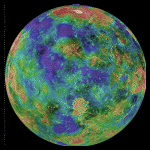 |
|||||||
| VENUS IS A BURNING-DESERT WORLD | |||||||
|---|---|---|---|---|---|---|---|
| Planet | Water | Greenhouse | Lightning | Spacecraft | Express | Transit | Resources |
 |
|||||||
| VENUS IS A BURNING-DESERT WORLD | |||||||
|---|---|---|---|---|---|---|---|
| Planet | Water | Greenhouse | Lightning | Spacecraft | Express | Transit | Resources |
Venus is a burning-desert world hidden under bitter clouds of sulfuric acid and carbon dioxide. It may once have been awash with oceans of near-boiling water.
VENUS
For hundreds of millions of years, most of the water on Venus was liquid near the boiling point. But the water finally dried up, according to scientists at NASA's Ames Research Center in Mountain View, California, south of San Francisco.
In what they call a moist-greenhouse or wet-greenhouse effect, the water on Venus was able to remain liquid for a few hundred million years because planet temperatures actually were cooler than Earth scientists once thought, and because of the proportion of carbon dioxide to water vapor in the atmosphere of Venus.
Venusian seas dried up slowly as hydrogen eventually escaped into space. Oxygen formed compounds with other elements and was incorporated into the planet's crust.
Scientists say liquid water seems essential to life. The Ames researchers said the oceans of Venus might still have been liquid at 200 to 300 degrees Fahrenheit because of intense pressure. But that may have been too hot for life to begin. If not, it may not have lasted long enough for life to begin.
VENUS
Learn more:
Venus
- Venus Planet Profile NASA JPL
- Venus Described SEDS Nine Planets
- Exploring Venus STO
- Exploring Venus index STO
- Planet Venus STO
- Venus Water STO
- Venus Greenhouse STO
- Venus Lightning STO
Venus Transit
- Venus Transit 2004 STO
- Guide to Viewing the Transit Science @ NASA
- Guide to Viewing the Transit Science @ NASA
- 2004 Venus Transit Resource Guide NASA Sun-Earth Connection
- Movies and diagrams of the transit Astronomy magazine
- Venus Transits of 2004 and 2012 NASA Goddard
- Guide to the Transit of Venus Sky & Telescope magazine
Captain James Cook
- James Cook and the Transit of Venus Science @ NASA
- James Cook and the Transit of Venus Blue Latitudes
- James Cook Journals National Library of Australia
- History of Cook's Endeavour HM Bark Endeavour Foundation
- James Cook Transit Timing Measurements Royal Society of London
- South Seas Voyaging National Library of Australia
- James Cook Drawings of 1769 Venus Transit Armagh Observatory
- Capt. Cook's Voyages Linda Hall Library History of Science
Exploring Venus and the Solar System
- Venus Spacecraft STO
- The Pioneers STO
- The Voyagers STO
- Exploring the Solar System STO
How to watch the Sun safely
- Safe Sunwatching Science @ NASA
- List of solar filter suppliers Sky & Telescope magazine
- Solar Filter Safety Sky & Telescope magazine
- Close-Up of a Star Sky & Telescope magazine
- A Beginner's Guide to Solar Observing Sky & Telescope magazine
Read more about the Solar System . . . Star: The Sun Inner Planets: Mercury Venus Earth Mars Outer Planets: Jupiter Saturn Uranus Neptune Pluto Other Bodies: Moons Asteroids Comets Beyond: Pioneers Voyagers